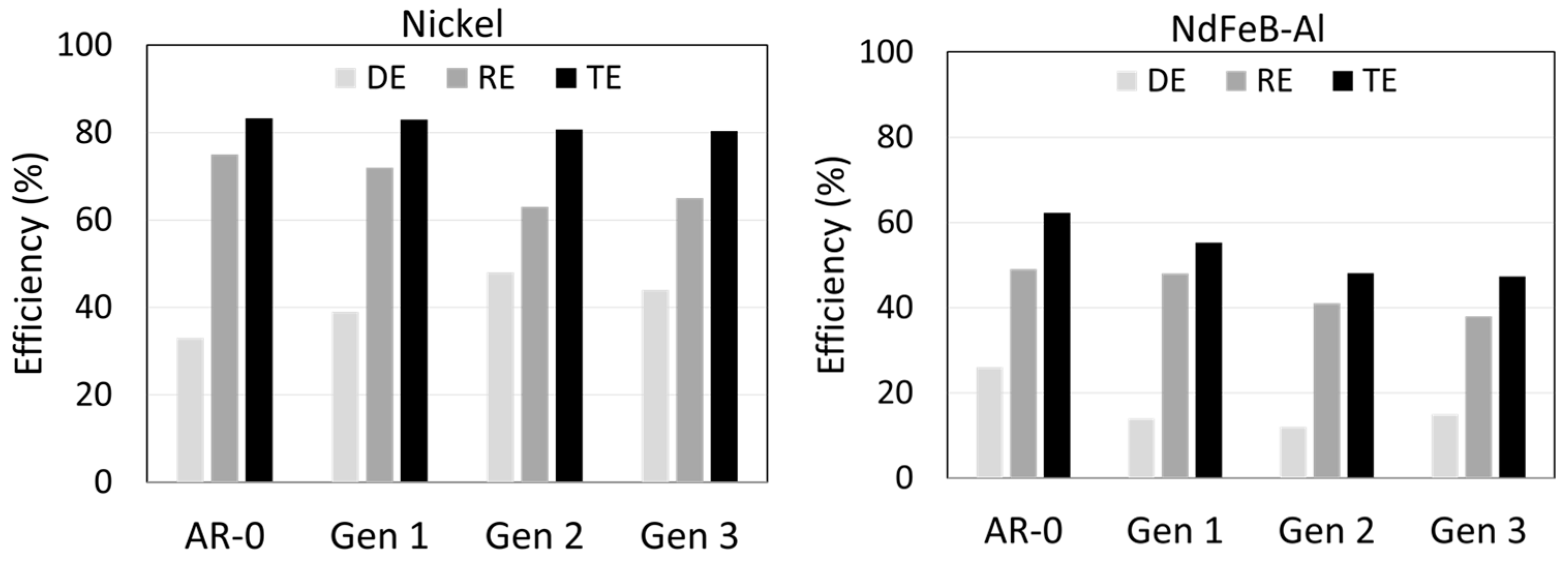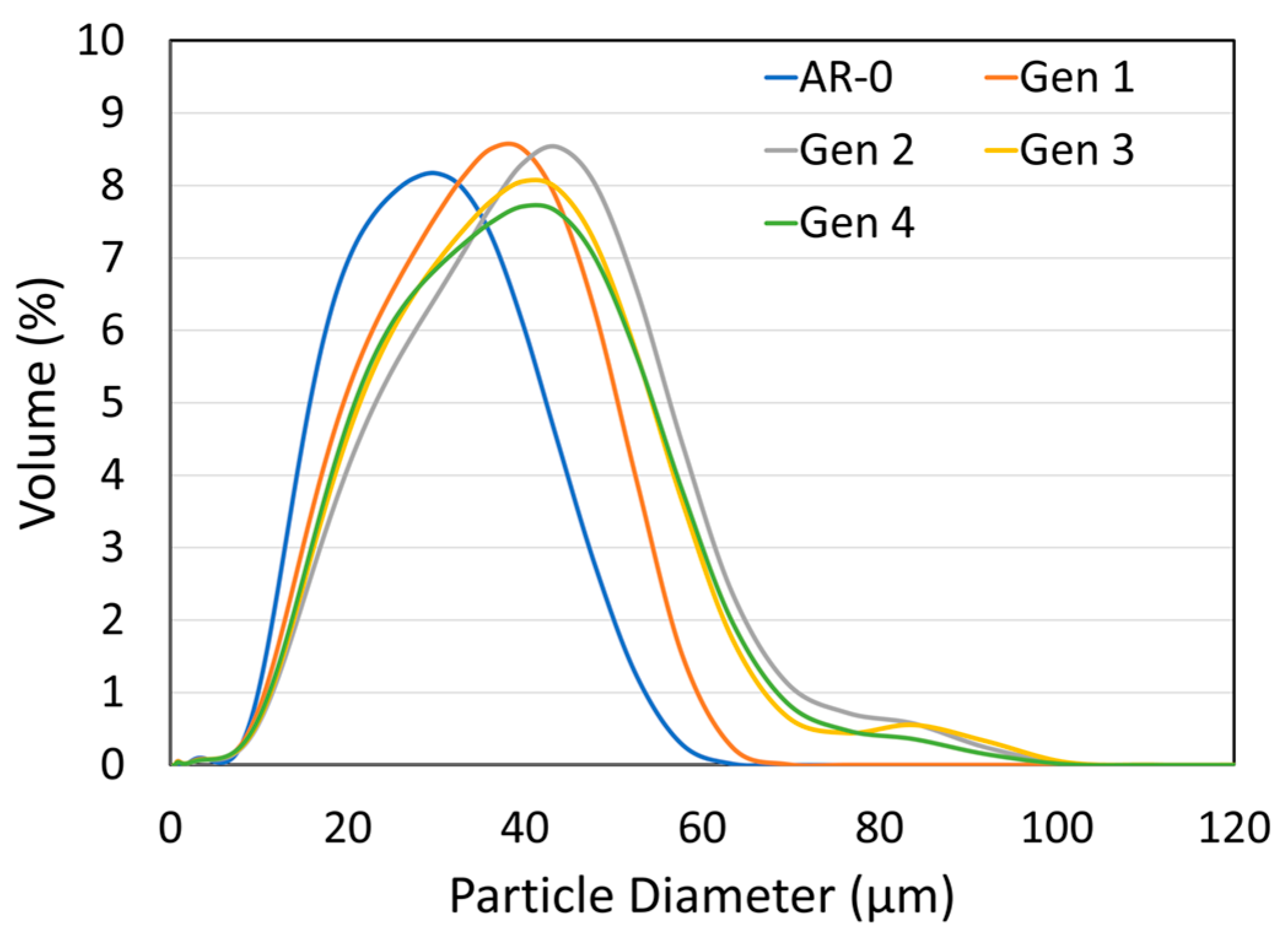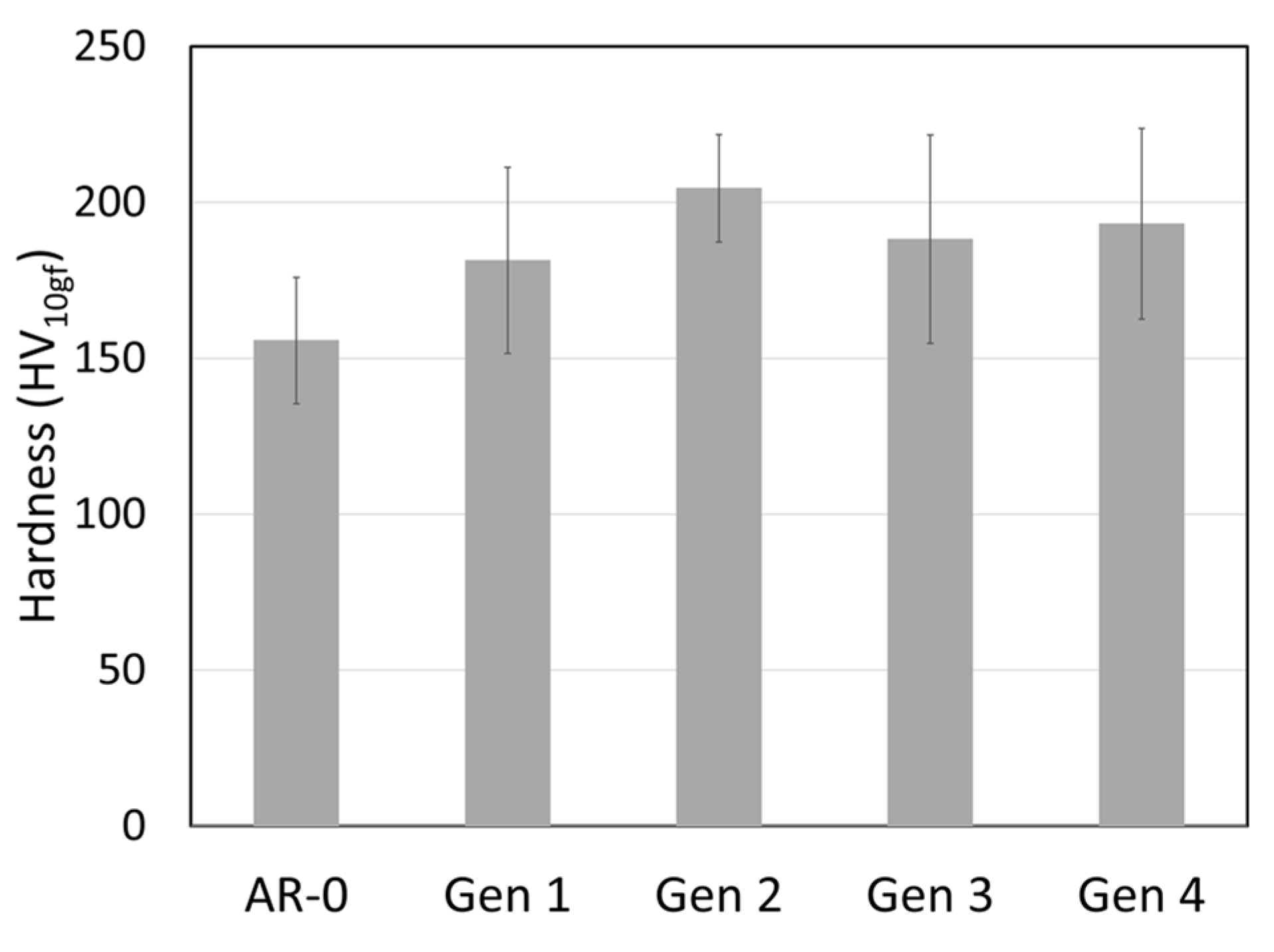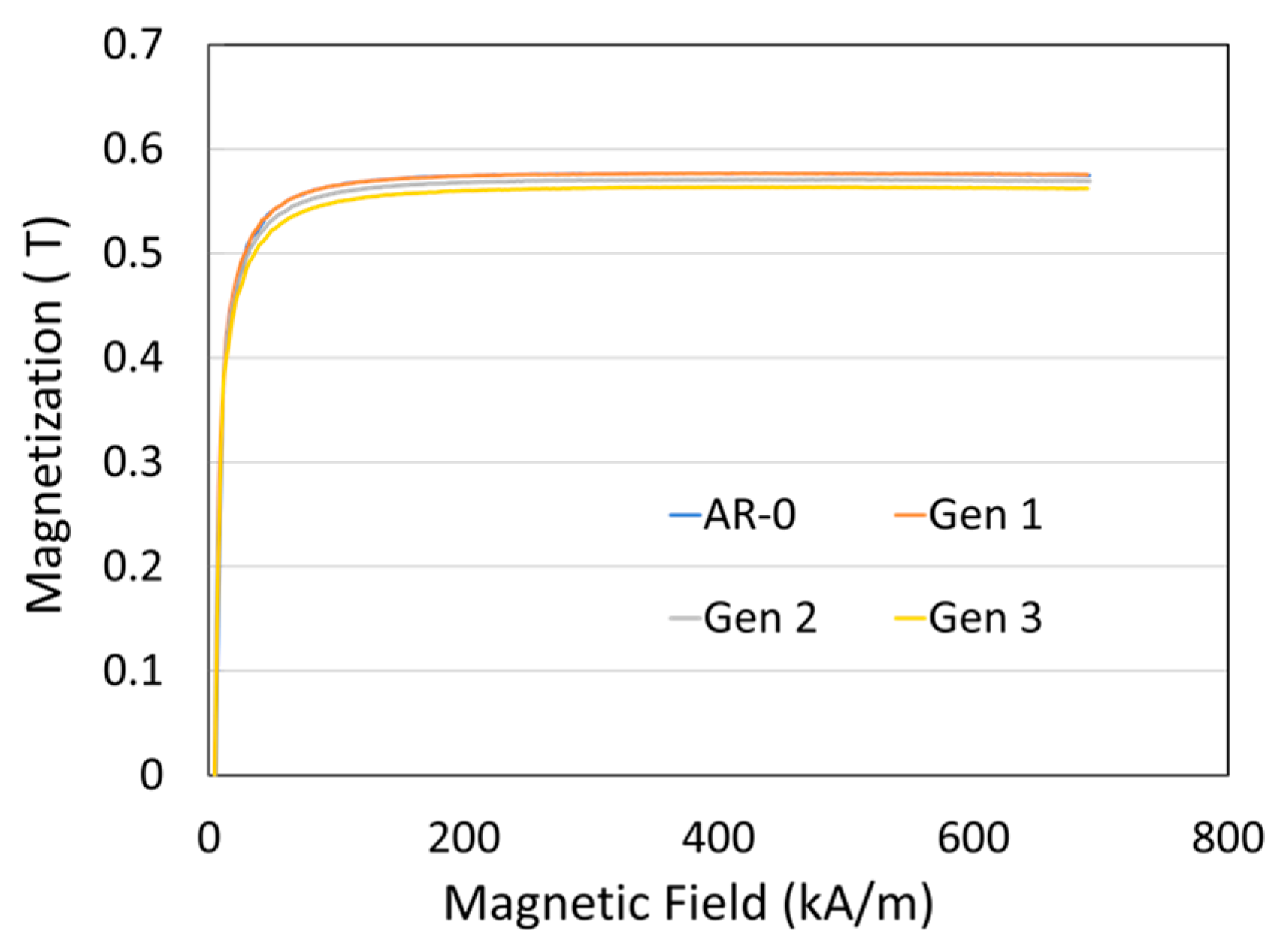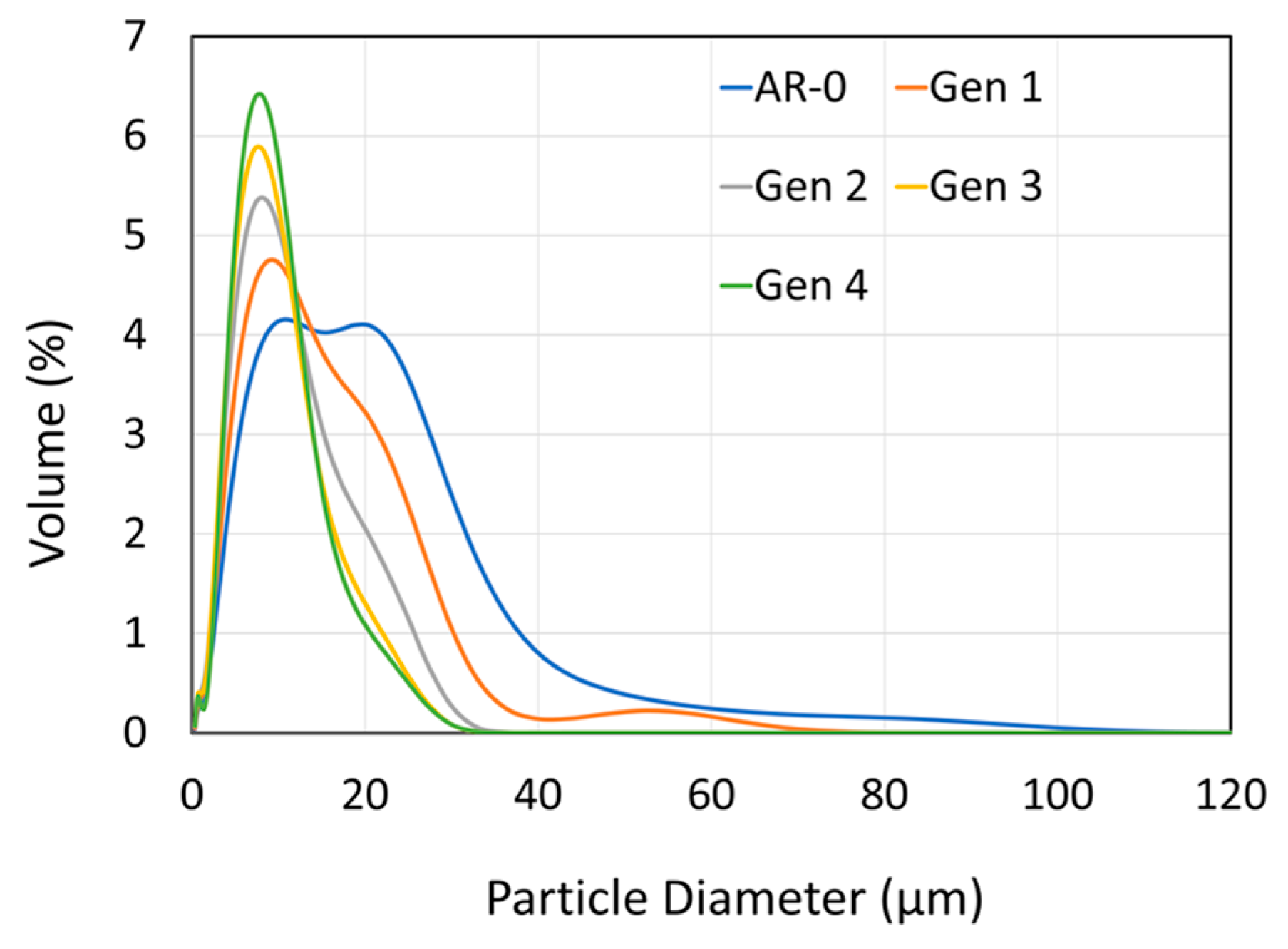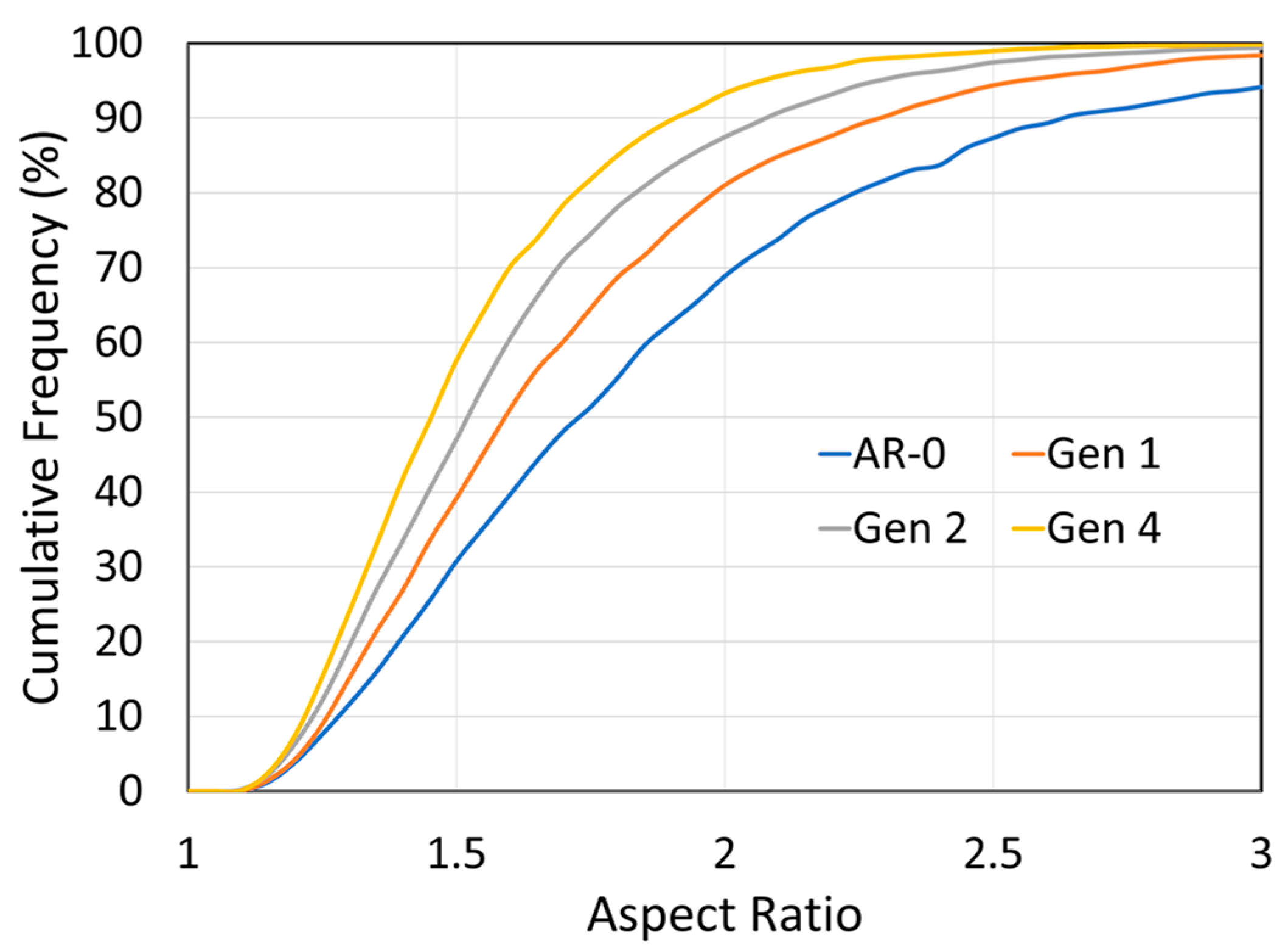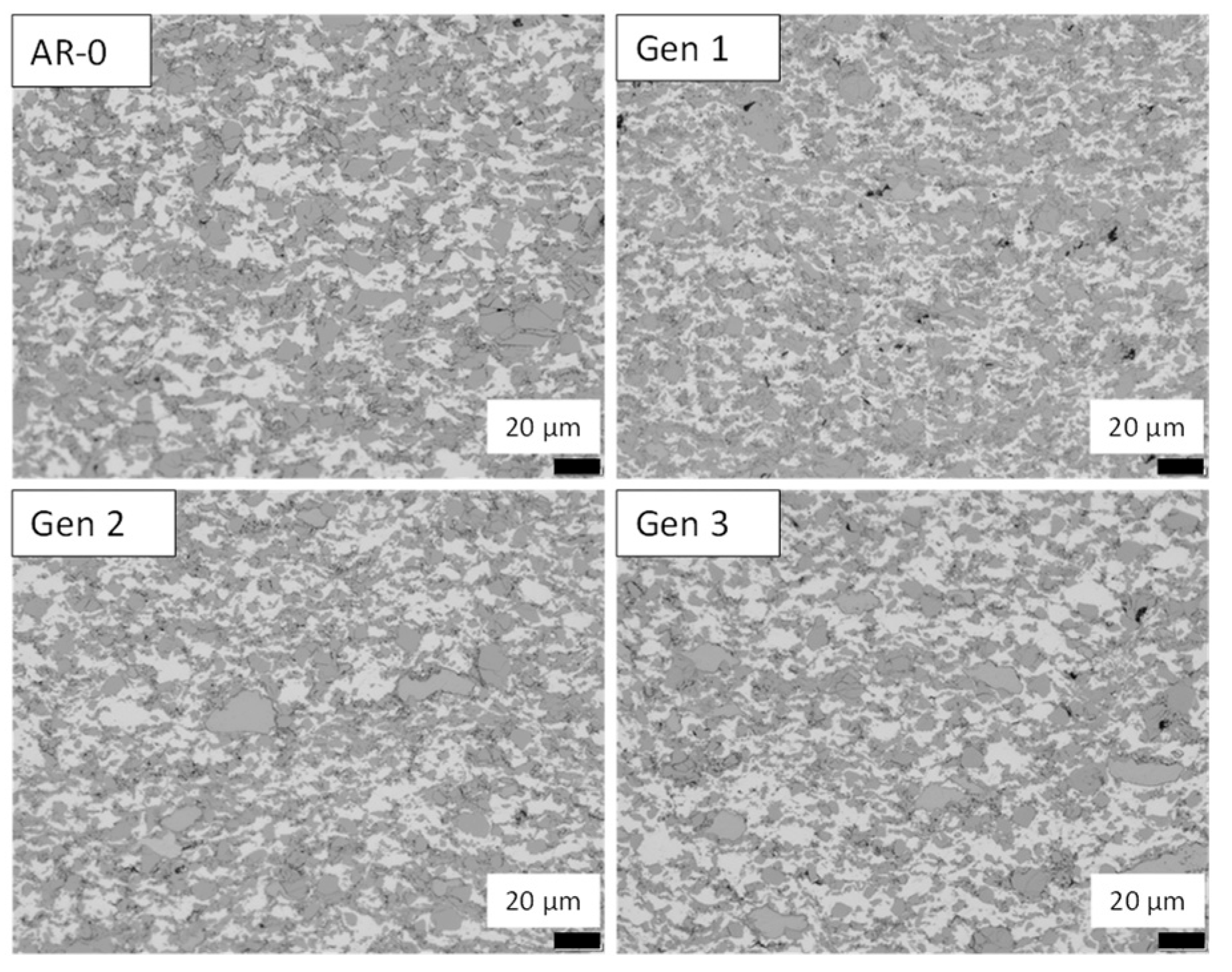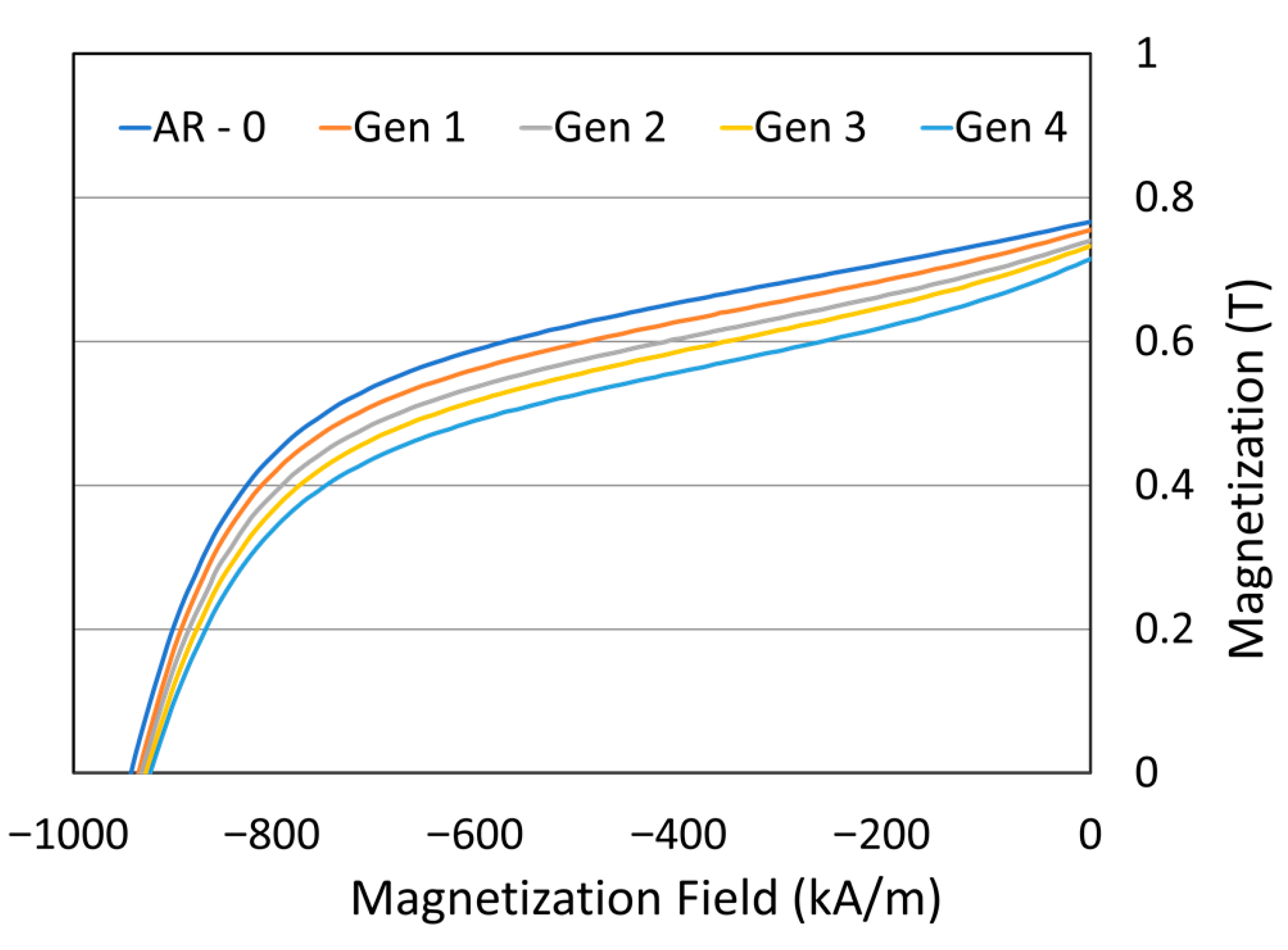1. Introduction
Increasing worldwide environmental targets are leading manufacturers to adopt more sustainable solutions and fabrication processes. In that context, electrification is rapidly expanding, which is reshaping material requirements, straining global supply chains, and more generally, creating challenges in terms of resource availability. These constraints have prompted several government bodies, such as those of Canada and the USA, to establish critical material lists and launch programs aimed at finding solutions to mitigate problems associated with the availability of these materials.
Additive manufacturing is a fabrication technique that can help address material availability issues by reducing material waste during production. Indeed, it has been demonstrated that additive manufacturing can produce near net shape parts, thus reducing the scrap and waste typically associated with subtractive manufacturing processes such as traditional machining [
1]. Among the various additive manufacturing techniques available, cold spray deposition offers several distinct advantages, including the capacity to process materials in solid-state form (i.e., without melting and with minimal oxidation), remarkably high deposition rates that can reach several kilograms per hour, and the production of coatings with particularly good mechanical properties [
2,
3].
While cold spray additive manufacturing can process several kilograms of material per hour, it can also result in significant material waste, as the deposition efficiency (DE), defined as the ratio of powder adhering to the part to the total powder used, can be suboptimal for certain material systems [
4]. DE is a complex function of process parameters, substrate nature and geometry, as well as the physical and chemical characteristics of the sprayed powder [
5,
6,
7]. The deposition of composite materials containing a hard and/or brittle phase may lead to particularly low DE, which can seriously limit the industrial viability of the cold spray process from an economic standpoint when processing expensive powders. In the context of limited availability of critical materials, wasting a significant portion of the sprayed material is unacceptable from economic, environmental, and socio-ethical perspectives.
Since increasing cold spray DE is not always technically feasible, as it is highly dependent on the inherent properties of the sprayed material, powder recovery and reuse can emerge as a promising strategy to reduce material waste. The idea of achieving 100% powder usage was identified as a potential advantage of cold spray in the early stage of its development. Indeed, Segall et al. [
8] suggested in 1998 that all particles rebounding during cold spray could eventually be reused. However, as the technology evolved, only limited efforts have been devoted to studying powder recovery and reuse, and the literature on the topic remains scarce. To date, powder reuse has been investigated only for MCrAlY [
9], copper [
10], and, more recently, for tin [
11].
Early results indicate that powder recovery is feasible, that the recovered powder is only moderately affected by the spray process, and that it can improve the process economics. Nevertheless, both Perry et al. [
10] and Zarazua-Villalobos et al. [
11] reported significant decreases in the recuperated powder DE. For example, the DE of recuperated copper dropped to 46% compared to 68% for the as-received powder [
10]. This decrease was attributed to changes in the particle size distribution as the particles with the most suitable characteristics are deposited during the first spray step as well as to particle work hardening. A similar effect was observed for tin, where deposition efficiencies for as-received and recuperated powders were 44% and 32%, respectively [
11]. For both materials, the DE of a blend of recuperated and fresh powders was higher than that of a fully recuperated powder, potentially due to interactions between softer and harder particles and the resulting coating compaction effect. In the case of tin, a small reduction in mean particle size was also observed and attributed to particle erosion and fragmentation. Notably, the cumulative effect of multiple recovery cycles has not yet been investigated in the literature.
In this paper, two powders, NdFeB and Ni, containing elements listed as critical or near-critical by the US Department of Energy [
12], were selected for investigation. The aim of the experiments was to study the effect of multiple spray-recovery cycles on the characteristics of these powders. Both powders are expensive (as of 2025) and are used in high value-added applications. The advantage of spraying NdFeB-Al composite powders for permanent magnets has been previously demonstrated, including for the fabrication of electric motor rotor prototypes using cold spray additive manufacturing [
13,
14]. Ni alloys, on the other hand, are widely used in cold spray aerospace repair applications [
15]. Both powders present vastly different mechanical properties and are thus expected to respond differently to particle impact. Indeed, NdFeB powder is brittle, has limited deformability, and is consequently sprayed in combination with a softer metallic binder such as aluminum. In contrast, Ni is ductile and can be readily deposited using standard cold spray parameters [
16,
17]. Furthermore, NdFeB magnetic properties are sensitive to phase degradation and oxidation at high temperature, making them susceptible to modification during successive spray operations [
18].
This paper presents results on the effects of recovery and reuse on the characteristics of both powders and the coatings produced from them. Specifically, the influence of up to four spray-recovery cycles was evaluated in terms of powder morphology and particle size distribution and compared to the original powders. In addition, coatings produced from these recuperated powders were characterized, and the results are discussed in relation to the intrinsic properties of each material. This paper evaluates the feasibility of recovering powders, with a focus on their magnetic properties, within the context of multiple recovery and reuse steps for sustainable industrial applications.
2. Methodology
2.1. Feedstock Preparation
Nickel (Amperit 176.068, Höganäs, Sweden), aluminum (H5, Valimet, Stockton, CA, USA), and NdFeB (MQFP-B, Neo-Magnequench, Toronto, ON, Canada) were used in this study.
Table 1 summarizes the powder size distributions and fabrication methods for each material. Prior to spraying, the NdFeB powder was mechanically mixed with Al powder for 1 h in a 90 wt.%-10 wt.% ratio. Aluminum was added to promote bonding between magnetic particles during deposition [
13].
2.2. Cold Spray Deposition
Cold spray deposition was carried out using a PCS-100 system (Plasma Giken Co., Saitama, Japan). The Ni powder and NdFeB-Al powder mix were sprayed using the parameters summarized in
Table 2. The NdFeB-Al spray parameters were optimized in previous work [
13], while Ni parameters were optimized to produce dense coatings at the same temperature. For both materials, a target feed rate of approximately 20 g/min was used. The substrate for Ni deposition was a 76 mm × 76 mm × 3 mm grit-blasted mild steel plate (ASTM A36). For NdFeB-Al deposition, a 76 mm × 76 mm × 6 mm as-received cold-rolled Al6061 plate was used.
2.3. Powder Recovery
Powder recovery during cold spray is uncommon in a R&D environment due to several challenges: (1) direct recovery from the dust collector is neither simple nor efficient; (2) contamination from other powders and materials may occur; and (3) handling fine metallic particles poses explosion hazards. Previous studies have recovered powder by lining the cold spray chamber with aluminum foil [
11] or using a custom powder reclamation chamber [
9]. An approach similar to the latter was adopted in this work: a custom recovery chamber was designed and assembled, as illustrated in
Figure 1, using extruded aluminum profiles and galvanized mild steel plates. The chamber consists of four zones: A—cold spray gun entrance, B—substrate holder area, C—gas deceleration area, and D—the exit chimney and filter. Deposition occurs in zone B, where the substrate is positioned perpendicular to the gun’s main spray axis. The back wall is placed more than 10 cm behind the substrate and angled to minimize unwanted deposition.
Multiple system iterations were developed and tested to achieve >50% recovery efficiency, considered a benchmark for industrial feasibility. This also ensures that the recovered powder is representative of the non-adhered fraction and provides sufficient material for re-spray experiments. The recovery chamber efficiency was improved using several means: (1) A high temperature rubber gasket sealing the gun nozzle to the chamber entrance was installed. The gasket is flexible enough to allow to lateral gun movement for deposition. (2) High-temperature silicon and gaskets were used to minimize gas leaks at the steel panels and aluminum profiles interfaces. (3) Internal panels were installed to lengthen the gas path and increase the travel time in zone C. (4) An exit chimney-like feature was installed in zone D. (5) An industrial-grade filter was installed at the chamber outlet to capture particles.
The recovery process involved spraying the powders using the parameters in
Table 2 inside the recovery chamber and collecting the substrate plates and recovered powders at regular intervals for characterization. Recovered powders were collected from zones C and D of the recovery chamber using a fine brush and a dust tray. An industrial solution for collection of the powders would still need to be developed. Powders were labeled by generation number (e.g., Generation 2 = sprayed and recovered twice; AR-0 = as-received powder was labeled as 0 since it has not been sprayed nor recovered). Coatings were labeled based on the powder generation that was used in their fabrication. As an example, a coating labeled generation 3 was sprayed with a powder of generation 3.
For the NdFeB-Al mix, due to differences in material properties and deposition behavior, Al powder was added after each recovery cycle, prior to the next spray step, to maintain the original mass fractions of each component. The quantity of Al added was determined from powder density measurements, carried out using a gas pycnometer (AccuPyc 1330, Micromeritics, Norcross, GA, USA). Powder was added to maintain a constant mix density consistent with the initial composition of 90 wt.% NdFeB and 10 wt.% Al.
2.4. Characterization
Several tests were performed to characterize the powders, including density, particle size, morphology, hardness, and magnetic performance. These tests were carried out on both the as-received powder and after each recovery cycle to evaluate the effect of successive spray runs on powder characteristics.
Particle size distributions were measured by laser diffraction (LS I3 320, Beckman Coulter, Indianapolis, IN, USA). Particle Vickers microhardness was obtained from polished resin-mounted samples using a 10-gf load (MMT-X7B, Matsuzawa Co., Tokyo, Japan). Powder magnetic properties, namely, remanence (ability to retain magnetization) and coercivity (resistance to demagnetization under a magnetic field), were measured with a Permagraph L (Magnet Physics, Cologne, Germany). For these measurements, a known quantity of powder was mixed into liquid epoxy, which was subsequently cured before testing.
Particle morphology was examined by scanning electron microscope (Apreo 2 15 kV, Thermofisher, Waltham, MA, USA). Magnification was selected to meet the ISO 9276-6 requirements for the minimum number of pixels required for accurate analysis of the smallest particles [
19]. Image analysis followed ISO 13322-1 [
20] using a dedicated software (Clemex Vision PE version 8.0.197, Clemex Technologies Inc., Longueuil, QC, Canada). Image quality was enhanced by applying a pruning function to remove single-pixel wide peaks and valleys, followed by segmentation and automatic bridge removal to separate touching particles [
21]. Among the measured morphological parameters (area, convexity, aspect ratio, compactness, roundness, roughness, extent), the aspect ratio was selected as the most representative for assessing the impact of recovery on morphological features.
Coatings produced at each iteration were characterized in terms of DE (i.e., the ratio of mass retained relative to total sprayed mass over a substrate), porosity, and magnetic properties (remanence and coercivity). The NdFeB volume fraction was determined by SEM image analysis and pycnometry. The same equipment and measurements methodologies were used for both powders and coatings.
3. Results
The recovery system described in
Section 2.3 was first used to spray the as-received Ni powder and NdFeB-Al powder mix, producing recovered powders of Generation 1. Each subsequent spray cycle used the recovered powders from the previous generation, up to production of powder of Generation 4.
To evaluate the system’s performance, the masses of sprayed, deposited, and recovered powders were measured. The sprayed powder mass was obtained by weighing the powder in the hopper before and after spray. The deposited mass was determined from the substrate weight change. The impinging mass was calculated from the effective feed rate and the robot’s movement parameters. From these values, the system/powder deposition efficiency (DE), recovery efficiency (RE), and total efficiency (TE) were calculated using the following equations:
In this study, the traditional definition of the DE was adopted, i.e., DE represents the mass ratio of deposited particles to that of impinging particles. RE measures the mass ratio of the non-adhered powder that is recovered. TE quantifies the fraction of the sprayed powder that is either deposited or recovered. These three ratios are linked together by Equation (4).
The results for Ni and NdFeB-Al recovered powders are presented in
Figure 2. For Ni, the as-received powder (AR-0) had a DE of 33%, which increased to 48% for Generation 2 before slightly decreasing to 44% for Generation 3. The RE for Ni was initially close to 75%, decreasing to ≈ 65% for Generations 2 and 3. The TE remained relatively stable, from 83% (AR-0) to 80% (Generation 3).
On the other hand, for NdFeB-Al, the AR-0 DE was 26%, dropping sharply to 14%, 12%, and 15% for Generations 1, 2, and 3, respectively. The RE was below 50% for AR-0 and declined to 38% by Generation 3. Consequently, the TE decreased from 62% (AR-0) to 47% (Generation 3). It is worth noting that producing enough Generation 4 powder for testing requires spraying a significant amount of AR-0 powder due to the system’s limited RE and the fraction of powder that is successfully deposited. This is particularly true for NdFeB-Al, where the RE is below 50%. Using the data in
Figure 2 and Equations (1)–(4), it was calculated that 12 kg of NdFeB-Al and 8 kg of Ni are needed to obtain 200 g of Generation 4 powder, enough for characterization. This limitation strongly restricts the number of generations that can be studied in a laboratory setting. However, spraying up to Generation 4 is sufficient to establish clear trends.
3.1. Nickel
The particle size distribution of the as-received Ni powder and the recovered powders from the subsequent generations are shown and compared in
Figure 3. The corresponding
d10,
d50, and
d90 values are summarized in
Table 3. The as-received Ni powder has a distribution mostly comprising particles between 14 µm (
d10) and 43 µm (
d90). After each spray-recovery cycle, the particle size increases as can be seen, for example, by comparing the size distribution of Generations 1 and 2. This is particularly evident in the
d90, which rises from 43 µm for the as-received powder (AR-0) to 49 µm and 57 µm for Generations 1 and 2, respectively. For Generations 2, 3, and 4, the
d90 stabilizes between 55 and 57 µm.
SEM micrographs comparing the morphologies of the as-received and recovered powders highlight that the AR-0 particles are generally more spherical and of uniform composition (
Figure 4). As the number of cycles increases, three notable observations can be made: (1) particles become significantly more angular which is visible by comparing powder AR-0, Generation 1, and Generation 4; (2) internal porosity becomes slightly more prevalent in recovered powders; and (3) there is no evidence of particle agglomeration or fusion after spraying.
Quantitative image analysis of 20 SEM images per generation was performed to characterize the evolution of the particle morphologies (see
Section 2.4). The particle aspect ratio is defined as the ratio of the particle’s long axis to its short axis. For the as-received Ni powder, the light blue curve in
Figure 5 shows that most particles are relatively equiaxed, with 70% having an aspect ratio below 1.3 and 90% below 1.5. A marked change occurs after the first spray-recovery cycle, with nearly 50% of particles exhibiting aspect ratios above 1.5, highlighting a clear morphological shift. As the generation number increases, the aspect ratio continues to rise slightly but stabilizes from Generations 3 to 4.
Recovered Ni powders were also characterized for density and hardness (
Figure 6 and
Figure 7). Powder density decreases slightly with the number of cycles, while the hardness increases significantly from just above 150 HV for AR-0 to nearly 200 HV for Generations 2 to 4.
Coatings produced from all generations reached thicknesses of up to 13 mm without delamination. All coatings were dense, with no visual differences in color or surface roughness between generations. Metallography observations (
Figure 8) show that coatings from AR-0 and Generation 3 powders are nearly identical, with minimal porosity and no significant defects. Coatings from Generations 1 and 2 displayed similar microstructures.
The magnetic properties of the coatings are shown in
Figure 9. All powder generations exhibited induction saturation values close to 0.57 T, with near-zero remanent magnetization once the magnetic field is removed.
3.2. NdFeB-Al
The NdFeB-Al powder mix was sprayed and recovered using the same procedure as for the Ni powder. The particle size distributions for the as-mixed powder (AR-0) and recovered powders (Generations 1 to 4) are shown in
Figure 10 and summarized in
Table 4. The initial powder mix exhibits a double Gaussian distribution, corresponding to the coarser NdFeB particles and the finer Al particles.
A significant change in particle size distribution occurs with increasing spray-recovery cycles: the fraction of large particles (>20 microns) decreases steadily, while the proportion of fine particles increases. This trend is reflected in the d90, which decreases from 28.8 µm down to 14.5 µm between AR-0 and Generation 4. The d50 follows a similar trend, from 11.2 µm to 7.3 µm, while the d10 remains nearly constant.
SEM cross-section images (
Figure 11) show that AR-0 consists of irregularly shaped NdFeB particles (light grey, rough edges) mixed with smaller, more spherical Al particles (darker grey). Both materials are dense and uniform in composition. One can readily observe a decrease both in aluminum and NdFeB particle size when comparing the micrographs of the Generation 2 powder with that of the AR-0 powder. By Generation 4, NdFeB particles appear less angular and more spherical compared to the AR-0 powder.
Image analysis results for the aspect ratio are shown in
Figure 12. In contrast to the Ni powder, the aspect ratio decreases with increasing spray-recovery cycles, which is consistent with the SEM observation that particles become more spherical. This trend shows no sign of saturation up to Generation 4, suggesting it would likely continue beyond.
Coating cross-sections for AR-0 and Generation 1 to 3 are presented in
Figure 13. As in the powder cross-sections, the NdFeB particles appear in dark grey, while the Al phase appears lighter. For all generations, the coatings exhibit good intersplat cohesion and low porosity, although the latter is slightly higher for coatings produced from re-sprayed powders compared with the as-mixed material. For example, a slightly higher void content can be observed when comparing AR-0 and Generation 1 micrographs. In both cases, the porosity remains below 1%.
Magnetic properties of the powders are shown in
Figure 14. The second quadrant of the demagnetization curve is presented, where the magnetic induction at zero field corresponds to the remanence, and the
x-axis intercept corresponds to the coercivity. Both remanence and coercivity show a slight decline with increasing generations, with the remanence decrease being more pronounced.
Table 5 summarizes the magnetic properties as well as densities of the magnets produced with powders of different generations. Remanence decreases progressively with generation number.

